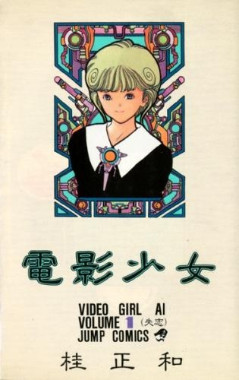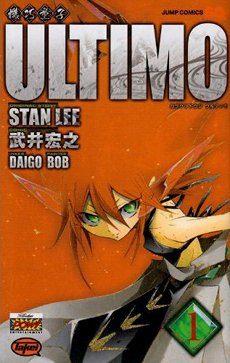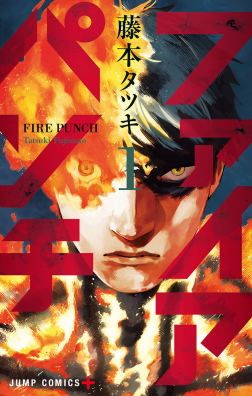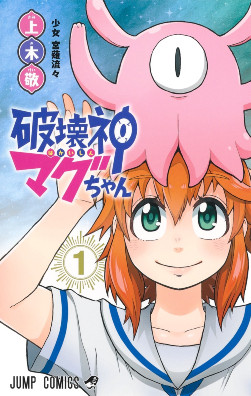(2006–2007)
Media
Manga
Written and illustrated by Hiroyuki Asada, Tegami Bachi debuted in Shueisha's Monthly Shōnen Jump on September 6, 2006. [5] The magazine ceased its publication on June 6, 2007. [6] [7] Following a special un-numbered one-shot chapter published in Weekly Shōnen Jump on October 15, 2007, [8] [9] the series was transferred to the then brand new magazine Jump Square on November 2 of the same year, [10] [11] where it ran until its conclusion on November 4, 2015. [12] [13] Shueisha collected its 99 individual chapters in twenty tankōbon volumes, released from January 4, 2007, [14] to January 4, 2016. [15]
Viz Media announced that it had licensed Tegami Bachi for an English-language adaption in North America at San Diego Comic-Con on February 28, 2010. [16] It was announced that Tegami Bachi, otherwise known as Letter Bee in English translations, will be serialized in the monthly manga anthology Shonen Jump , where it replaced the manga series Slam Dunk . [16] It debuted in the March 2009 issue of the magazine. [16]
Drama CD
A drama CD, which adapted the Jiggy Pepper arc, was released on February 16, 2009. [17]
Anime
A special anime adaptation, running for about 30 minutes, was shown during the Jump Super Anime Tour events in Japan in the fall of 2008. [18] It was titled Tegami Bachi: Hikari to Ao no Gensō Yawa (テガミバチ 〜光と青の幻想夜話〜, Letter Bee: Light and Blue Night Fantasy), and was animated by Pierrot+. An original video animation was translated for free by Anthony Carl Kimm on the Jumpland website with English subtitles. [18] It was later released on DVD in the beginning of 2009.
In April 2009, it was announced that Tegami Bachi would receive an anime television series adaptation. [19] The series was directed by Akira Iwanaga. [20] The series aired on TV Tokyo, TV Osaka, TV Aichi and other affiliated television networks from October 3, 2009, to March 27, 2010. [21] [22] The first opening theme song is Hajimari no Hi (はじまりの日), performed by Suga Shikao featuring Mummy-D. [22] The second opening theme song is Love Letter no Kawari ni Kono Uta O (ラブレターのかわりにこの詩を。, lit. Rather than a Love Letter, Choose This Poem), performed by Seira. [23] In Southeast Asia, the series aired on Animax Asia under the title Letter Bee. [4]
A second season, Tegami Bachi Reverse, was announced in February 2010. [24] The second season aired from October 3, 2010, to March 26, 2011. [24] The first opening theme song is Chiisana Mahō (小さな魔法, Little Magic), performed by Stereopony, [25] while the first ending theme song is Wasurenagusa (勿忘草, Forget-Me-Not), performed by Piko. [26] The second opening theme song is Yakusoku (約束, Promise), performed by Suga Shikao, [27] while the second ending theme Perseus (ペルセウス, Perseus), performed by Yamazaru. [28]
In North America, both seasons have been licensed by Sentai Filmworks. [29] [30]
Reception
Manga
Deb Aoki of About.com reviewed Tegami Bachi Volume 1. [31] Aoki said that the series "has the right stuff to appeal to both male and female readers: thrilling action, a magical world full of mysteries, likeable characters that are worth caring about, and lovely artwork, all done with a touch of light-hearted humor." [31]
In Japan, volume 2 of the manga debuted sixth during the first week of its release. [32]
Anime
Carlo Santos of Anime News Network reviewed the first 6 episodes of Tegami Bachi. [33] He commented that the series "may be one of the last few adventure series that is genuinely about adventure" and "an adventure with a unique vibe". [33] Santos went on to say how the series as a whole isn't like typical adventure series, which deal with "the triumphs and tragedies of having the best sword", as it is built on "the triumphs and tragedies of the human heart". [33] A negative point he said was about the animation—describing the Gaichuu as "plastic-looking CGI beasts looking woefully out of place among the scenery". [33] However, Santos complimented the series' art direction by saying that "the artistry is far more commendable: the blend of feudal and industrial eras results in a unique visual aesthetic". [33] Overall, Santos gave a positive review of the first 6 episodes of Tegami Bachi with an overall grade of B−. [33]
Related Research Articles

Video Girl Ai, known in Japan as simply Video Girl, is a Japanese manga series written and illustrated by Masakazu Katsura. It was serialized in Shueisha's shōnen manga magazine Weekly Shōnen Jump from December 1989 to April 1992. It was followed by a short sequel entitled Video Girl Len, published between April and July 1992. The manga was compiled into fifteen tankōbon volumes by Shueisha and published between July 1990 and March 1993.
Noriaki Kubo, known professionally as Tite Kubo, is a Japanese manga artist and character designer. His manga series Bleach (2001–2016) had over 130 million copies in circulation as of 2022.

Monthly Shōnen Jump was a shōnen manga magazine which was published monthly in Japan by Shueisha from 1970 to 2007 under the Jump line of magazines. It was the sister magazine to Weekly Shōnen Jump.

Jump Square, also written as Jump SQ. (ジャンプSQ.), is a Japanese monthly shōnen manga magazine. Published by Shueisha, the magazine premiered on November 2, 2007, as a replacement for Monthly Shōnen Jump, another manga anthology that Shueisha discontinued in June of that year. The magazine is a part of the Jump line of magazines. The manga titles serialized in the magazine are also published in tankōbon volumes under the Jump Comics SQ. imprint. Shueisha reported that readers of Jump Square tend to range from 15 to 34 years of age. The current (2015) editor-in-chief is Kôsuke Yahagi.
Hiroyuki Asada is a Japanese manga artist who is best known for his gaslamp fantasy series Tegami Bachi. The first manga series he created was called I'll, and was a basketball series. All of Asada's manga were serialized in the monthly shōnen anthology Monthly Shōnen Jump. He made his debut in 1986. He acquired a fanbase with Mint: Sleeping Rabbit, Renka by degrees, and his popularity improved with I'll. In his personal life, he is part of a unit with Shou Tajima and Takeshi Obata, and his creation activity with "AQUARIOS 3".
Dragon Ball: Yo! Son Goku and His Friends Return!! is a 35-minute Japanese animated short film based on Akira Toriyama's Dragon Ball series, shown on the Jump Super Anime Tour from September 21 to November 23, 2008. It was the first animated Dragon Ball film in twelve years, following the tenth anniversary film The Path to Power.

Ultimo, full title Karakuridôji Ultimo, is a Japanese manga series created by American comic writer Stan Lee and illustrated by Hiroyuki Takei. The plot of the story depicts a conflict between good and evil, implicated through the Karakuridôji created by the character Dr. Dunstan. The pilot chapter "Karakuridôji Ultimo: Chapter 0" was originally published in a special issue of Jump Square, called Jump SQ.II, on April 18, 2008. The series Ultimo was first serialized in Jump Square in March 2009, and it continued monthly serialization. Shueisha also published Ultimo in tankōbon format—the first published on July 3, 2009, and the fifth on November 4, 2010.

All You Need Is Kill is a Japanese science fiction light novel by Hiroshi Sakurazaka with illustrations by Yoshitoshi Abe. The book was published in Japanese by Shueisha under their Super Dash Bunko imprint in December 2004, and was later released in English by Viz Media under their Haikasoru imprint. All You Need Is Kill follows a soldier named Keiji Kiriya, who, after dying in a battle with extraterrestrials, is caught in a time loop that makes him live the same day repeatedly, allowing Kiriya to improve his fighting skills.

Weekly Shonen Jump was a digital shōnen manga anthology published in North America by Viz Media, and the successor to their monthly print anthology Shonen Jump. It began serialization on January 30, 2012, as Weekly Shonen Jump Alpha, with two free preview issues published in the buildup to its launch. Based on Shueisha's popular Japanese magazine of the same name, Weekly Shonen Jump was an attempt to provide English-speaking readers with easily accessible, affordable, and officially licensed editions of the latest installments of popular Shōnen Jump manga soon after their publication in Japan, as an alternative to popular bootleg scanlation services which were illegal and often poorly translated. It attempts to copy the Japanese magazine.

Samurai 8: The Tale of Hachimaru is a Japanese manga written by Masashi Kishimoto and illustrated by Akira Okubo. It was serialized in Shueisha's Weekly Shōnen Jump from May 2019 to March 2020, with its chapters collected in five tankōbon volumes. In North America, Viz Media published the series on the Shonen Jump platform, and started the print release of the series in March 2020. Shueisha published it on the Manga Plus platform.

Fire Punch is a Japanese web manga series written and illustrated by Tatsuki Fujimoto. It was serialized through Shueisha's Shōnen Jump+ website from April 2016 to January 2018, with its chapters collected in eight tankōbon volumes. In North America, Viz Media licensed the manga for English release.

Magu-chan: God of Destruction is a Japanese manga series written and illustrated by Kei Kamiki. It was serialized in Shueisha's Weekly Shōnen Jump magazine from June 2020 to February 2022, with its chapters collected into nine tankōbon volumes. Viz Media has licensed the series for English release in North America.

Me & Roboco is a Japanese manga series written and illustrated by Shuhei Miyazaki. It has been serialized in Shueisha's Weekly Shōnen Jump since July 2020. The series is published digitally in English language by Viz Media. A 28-episode anime television series adaptation produced by Gallop was broadcast on TV Tokyo from December 2022 to June 2023. An anime film adaptation is set to premiere in April 2025.

Phantom Seer is a Japanese manga series written by Togo Goto and illustrated by Kento Matsuura. It was serialized in Shueisha's Weekly Shōnen Jump from August 2020 to April 2021, with its chapters collected in four tankōbon volumes. It was published digitally in English by Viz Media and Manga Plus.

Blue Box is a Japanese manga series written and illustrated by Kouji Miura. It has been serialized in Shueisha's Weekly Shōnen Jump since April 2021, with its chapters collected in 17 tankōbon volumes as of October 2024. An anime television series adaptation produced by TMS Entertainment and animated by Telecom Animation Film premiered in October 2024.

PPPPPP is a Japanese musical manga series written and illustrated by Mapollo 3. It was serialized in Shueisha's Weekly Shōnen Jump from September 2021 to February 2023, with its chapters collected into eight tankōbon volumes as of May 2023. The manga has been licensed for English release in North America by Viz Media.

Doron Dororon (ドロンドロロン) is a Japanese manga series written and illustrated by Gen Oosuka. It was serialized in Weekly Shōnen Jump from November 2021 to August 2022, and its chapters have been collected into five tankōbon volumes.

Romantic Killer is a Japanese manga series written and illustrated by Wataru Momose. It was serialized in Shueisha's Shōnen Jump+ website from July 2019 to June 2020, with its chapters collected in four tankōbon volumes.
References
- 1 2 "The Official Website for Tegami Bachi". Viz Media. Archived from the original on August 15, 2018. Retrieved March 11, 2018.
- 1 2 Aoki, Deb. "Fall 2009 New Manga Preview". About.com . Archived from the original on September 14, 2009. Retrieved May 17, 2022.
Currently featured in Shonen Jump magazine, Tegami Bachi features a mix of fantasy, action and steampunk-flavored sci-fi, all wrapped up in a beautifully drawn package.
- ↑ "Viz Media to Debut the Imaginative Steampunk Action Manga Series Tegami Bachi: Letter Bee" (Press release). Viz Media. August 24, 2009. Archived from the original on September 30, 2019. Retrieved January 7, 2020– via Anime News Network.
- 1 2 "Animax Asia airs Letter Bee". Animax Asia, Sony India. Archived from the original on February 19, 2012. Retrieved March 27, 2013.
- ↑ Hiroyuki, Asada (September 2, 2006). はじめまして「asada hiroyuki.com」です. asadahiroyuki.com (in Japanese). Archived from the original on October 11, 2007. Retrieved October 22, 2021.
- ↑ Macdonald, Christopher (April 6, 2007). "Shueisha to Launch New Monthly Magazine". Anime News Network . Archived from the original on March 20, 2021. Retrieved October 22, 2021.
- ↑ Loo, Egan (June 4, 2007). "More Revealed on Monthly Shonen Jump's Aftermath". Anime News Network . Archived from the original on August 8, 2022. Retrieved October 22, 2021.
- ↑ Loo, Egan (April 29, 2007). "Four Monthly Shonen Jump Titles to Run After Mag's End". Anime News Network . Archived from the original on April 25, 2019. Retrieved April 25, 2019.
- ↑ 週刊少年ジャンプ 2007年新年46号 (in Japanese). Shueisha. Archived from the original on February 5, 2008. Retrieved October 22, 2021.
- ↑ Loo, Egan (July 5, 2007). "Jump Square to Replace Monthly Shonen Jump in November". Anime News Network . Archived from the original on June 27, 2018. Retrieved April 25, 2019.
- ↑ 【ジャンプスクエア】ジャンプSQ.創刊号、11月2日発売!!. manganohi.jp (in Japanese). November 2, 2007. Archived from the original on December 2, 2007. Retrieved October 23, 2021.
- ↑ Pienda, Rafael Antonio (October 4, 2015). "Tegami Bachi Manga Ends Magazine Run on November 4". Anime News Network . Archived from the original on April 25, 2019. Retrieved April 25, 2019.
- ↑ 「テガミバチ」約9年の連載に幕、「テガミ」運ぶ郵便配達員のファンタジー. Comic Natalie (in Japanese). Natasha, Inc. November 4, 2015. Archived from the original on October 23, 2021. Retrieved October 23, 2021.
- ↑ テガミバチ/1 [Tegami Bachi 1] (in Japanese). Shueisha. Archived from the original on June 29, 2013. Retrieved April 27, 2020.
- ↑ テガミバチ/20 [Tegami Bachi 20] (in Japanese). Shueisha. Archived from the original on January 17, 2016. Retrieved April 27, 2020.
- 1 2 3 "Viz Picks Up Wāq Wāq, Tegami Bachi Manga". Anime News Network . July 25, 2008. Archived from the original on September 16, 2011. Retrieved September 20, 2011.
- ↑ テガミバチ ドラマ (CD). Shueisha. ASIN 4089011671.
- 1 2 "LETTER BEE". Jumpland. Archived from the original on December 24, 2008. Retrieved December 12, 2008.
- ↑ "Tegami Bachi Manga Gets TV Anime Green-Lit for October (Update 2)". Anime News Network . April 30, 2009. Archived from the original on May 3, 2009. Retrieved September 20, 2011.
- ↑ 浅田弘幸「テガミバチ」地上波TVアニメ化決定. Comic Natalie (in Japanese). Natasha, Inc. May 2, 2009. Archived from the original on September 27, 2010. Retrieved September 22, 2011.
- ↑ Loo, Egan (September 28, 2009). "Crunchyroll Gets Tegami Bachi: Letter Bee TV Anime (Update 2)". Anime News Network . Archived from the original on May 28, 2019. Retrieved January 7, 2020.
- 1 2 スガシカオがアニメ版「テガミバチ」主題歌に新曲提供. Music Natalie (in Japanese). Natasha, Inc. September 7, 2009. Archived from the original on September 24, 2012. Retrieved September 22, 2011.
- ↑ 星羅ニューシングルはアニメ「テガミバチ」新OPテーマ. Music Natalie (in Japanese). Natasha, Inc. December 4, 2009. Archived from the original on September 24, 2012. Retrieved September 22, 2011.
- 1 2 "Tegami Bachi: Leter Bee's 2nd Anime Season Airs in Fall". Anime News Network . February 28, 2010. Archived from the original on March 2, 2010. Retrieved September 20, 2011.
- ↑ "ステレオポニー インフォメーション" . Retrieved October 2, 2010.
- ↑ "ピコ Official Web Site Information" . Retrieved October 2, 2010.
- ↑ "Suga Shikao Official Website: Release" . Retrieved January 11, 2011.
- ↑ TV NEWS ニュース:NO DOUBT TRACKS Official Web Site . Retrieved January 11, 2011.
- ↑ Loo, Egan. "Sentai Filmworks Licenses Penguindrum, Ninja Scroll Film, Letter Bee". Anime News Network . Archived from the original on September 4, 2012. Retrieved September 2, 2012.
- ↑ "Sentai Filmworks Licenses Tegami Bachi Reverse Anime". Anime News Network . Archived from the original on January 5, 2013. Retrieved January 3, 2013.
- 1 2 "Tegami Bachi Volume 1 Review". About.com. Archived from the original on September 25, 2009. Retrieved October 8, 2009..
- ↑ "Japanese Comic Ranking, June 5–June 11". Anime News Network . June 13, 2007. Archived from the original on November 22, 2008. Retrieved September 20, 2011.
- 1 2 3 4 5 6 Santos, Carlo (November 20, 2009). "Tegami Bachi: Letter Bee Episodes 1–6 streaming – Review". Anime News Network . Archived from the original on March 24, 2010. Retrieved May 5, 2010.
External links
- Official website (in Japanese)
- Official manga website at Shueisha at the Wayback Machine (archived 2007-10-23)(in Japanese)
- Official manga website at Viz Media
- PSP game website (in Japanese)
- Tegami Bachi (manga) at Anime News Network 's encyclopedia
| Tegami Bachi | |
 First tankōbon volume cover, featuring Lag Seeing (front) and Gauche Suede (back) | |
| テガミバチ | |
|---|---|
| Genre | |
| English magazine | |
| Demographic | Shōnen |
| Original run | September 6, 2006 – November 4, 2015 |
| Volumes | 20 |
Monthly Shōnen Jump series | |
|---|---|
| 1970s–80s |
|
| 1990s |
|
| 2000s |
|
† Indicates titles that continued serialization in other magazines | |